微观经济学:GeneralEquilibriumandEconomicEfficiency
- 格式:pdf
- 大小:1.46 MB
- 文档页数:9
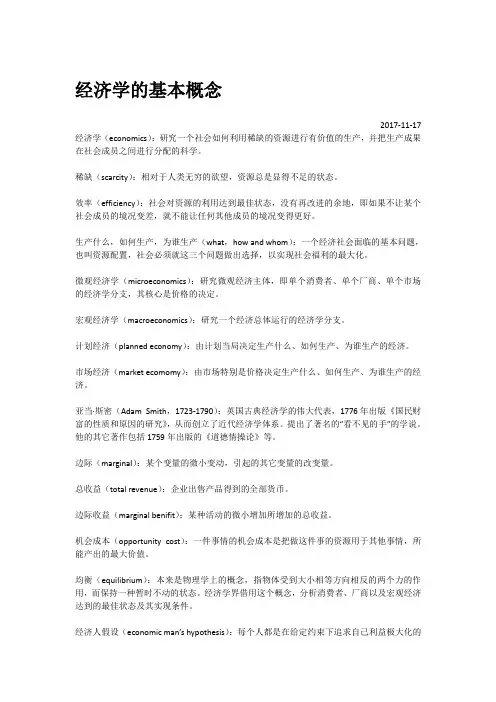
经济学的基本概念2017-11-17 经济学(economics):研究一个社会如何利用稀缺的资源进行有价值的生产,并把生产成果在社会成员之间进行分配的科学。
稀缺(scarcity):相对于人类无穷的欲望,资源总是显得不足的状态。
效率(efficiency):社会对资源的利用达到最佳状态,没有再改进的余地,即如果不让某个社会成员的境况变差,就不能让任何其他成员的境况变得更好。
生产什么,如何生产,为谁生产(what,how and whom):一个经济社会面临的基本问题,也叫资源配置,社会必须就这三个问题做出选择,以实现社会福利的最大化。
微观经济学(microeconomics):研究微观经济主体,即单个消费者、单个厂商、单个市场的经济学分支,其核心是价格的决定。
宏观经济学(macroeconomics):研究一个经济总体运行的经济学分支。
计划经济(planned economy):由计划当局决定生产什么、如何生产、为谁生产的经济。
市场经济(market ecomomy):由市场特别是价格决定生产什么、如何生产、为谁生产的经济。
亚当·斯密(Adam Smith,1723-1790):英国古典经济学的伟大代表,1776年出版《国民财富的性质和原因的研究》,从而创立了近代经济学体系。
提出了著名的“看不见的手”的学说。
他的其它著作包括1759年出版的《道德情操论》等。
边际(marginal):某个变量的微小变动,引起的其它变量的改变量。
总收益(total revenue):企业出售产品得到的全部货币。
边际收益(marginal benifit):某种活动的微小增加所增加的总收益。
机会成本(opportunity cost):一件事情的机会成本是把做这件事的资源用于其他事情,所能产出的最大价值。
均衡(equilibrium):本来是物理学上的概念,指物体受到大小相等方向相反的两个力的作用,而保持一种暂时不动的状态。
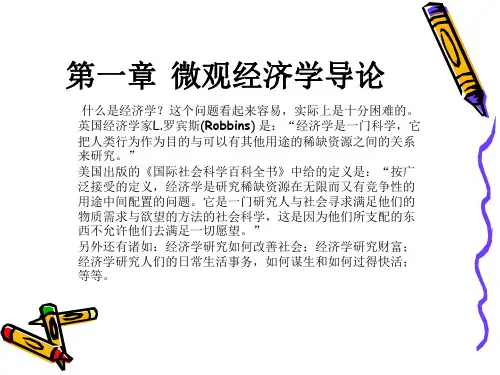
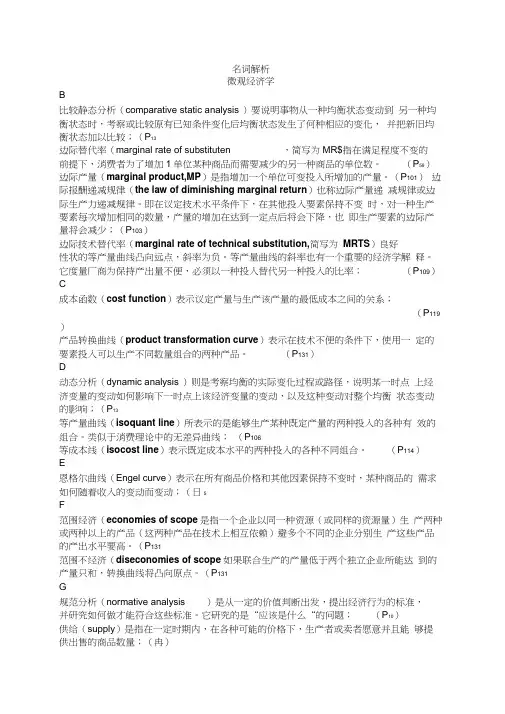
名词解析微观经济学B比较静态分析(comparative static analysis )要说明事物从一种均衡状态变动到另一种均衡状态时,考察或比较原有已知条件变化后均衡状态发生了何种相应的变化,并把新旧均衡状态加以比较;(P13边际替代率(marginal rate of substituten ,简写为MR$指在满足程度不变的前提下,消费者为了增加1单位某种商品而需要减少的另一种商品的单位数。
(P59)边际产量(marginal product,MP)是指增加一个单位可变投入所增加的产量。
(P101)边际报酬递减规律(the law of diminishing marginal return)也称边际产量递减规律或边际生产力递减规律。
即在议定技术水平条件下,在其他投入要素保持不变时,对一种生产要素每次增加相同的数量,产量的增加在达到一定点后将会下降,也即生产要素的边际产量将会减少;(P103)边际技术替代率(marginal rate of technical substitution,简写为MRTS)良好性状的等产量曲线凸向远点,斜率为负。
等产量曲线的斜率也有一个重要的经济学解释。
它度量厂商为保持产出量不便,必须以一种投入替代另一种投入的比率;(P109)C成本函数(cost function)表示议定产量与生产该产量的最低成本之间的关系;(P119)产品转换曲线(product transformation curve)表示在技术不便的条件下,使用一定的要素投入可以生产不同数量组合的两种产品。
(P131)D动态分析(dynamic analysis )则是考察均衡的实际变化过程或路径,说明某一时点上经济变量的变动如何影响下一时点上该经济变量的变动,以及这种变动对整个均衡状态变动的影响;(P13等产量曲线(isoquant line)所表示的是能够生产某种既定产量的两种投入的各种有效的组合。
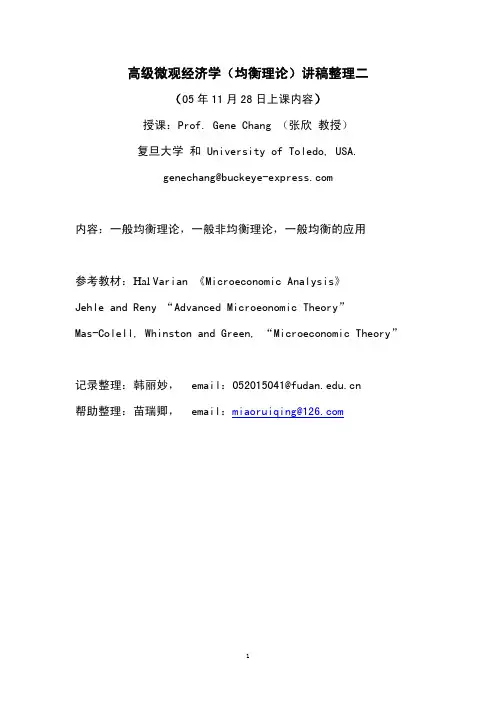
高级微观经济学(均衡理论)讲稿整理二(05年11月28日上课内容)授课:Prof. Gene Chang (张欣 教授)复旦大学 和 University of Toledo, USA.genechang@内容:一般均衡理论,一般非均衡理论,一般均衡的应用参考教材:Hal Varian 《Microeconomic Analysis》Jehle and Reny “Advanced Microeonomic Theory”Mas-Colell, Whinston and Green, “Microeconomic Theory”记录整理:韩丽妙, email:052015041@帮助整理:苗瑞卿, email:miaoruiqing@在 1.3我们讨论了为保证一般均衡的存在,消费方面必须满足的一些条件,在1.4中我们将继续讨论为保证一般均衡的存在,在生产集方面必须满足的条件。
这些条件主要是Debreu 建立的。
1.4生产理论我们研究的经济共有1,...,j n =个商品和市场。
厂商k 在可行的条件下有不同生产计划选择。
每个生产计划记为1(,...,)n k k y y =k y 。
若j k y 0<,为生产中的纯投入品。
或>0,则k 为生产中的纯产出品。
k k j y下面为了记号简洁,我们假设一个厂商生产一种商品,所以共有1,...,j n = 个厂商和商品。
厂商k 的所有可供选择的生产计划为他的生产可能性集,或生产集。
即:j Y :表示厂商j 的生产集,j Y =j y U ;Y :表示整个经济的生产集,nj jY Y =∑;二, 基本假设对任何一个厂商而言,为了保证一般均衡的存在,其生产集应该满足以下条件。
(1)n j R Y ∈∈}0{生产集在实数空间。
原点属于生产集,表示所有的投入与产出都为0。
这意味着工厂可以无所作为,既不生产,也不投入。
}0{(2) ,即生产集和正空间的唯一交集是;}0{=+n j R Y I }0{正空间(除外)不属于生产集。

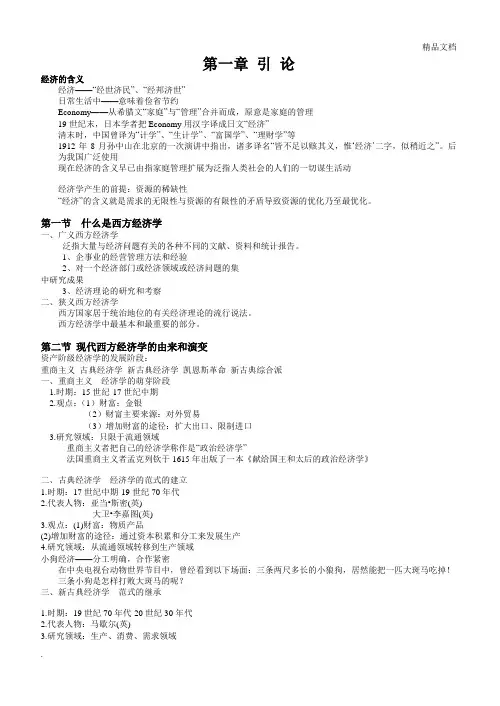
第一章引论经济的含义经济——“经世济民”、“经邦济世”日常生活中——意味着俭省节约Economy——从希腊文“家庭”与“管理”合并而成,原意是家庭的管理19世纪末,日本学者把Economy用汉字译成日文“经济”清末时,中国曾译为“计学”、“生计学”、“富国学”、“理财学”等1912年8月孙中山在北京的一次演讲中指出,诸多译名“皆不足以赅其义,惟‘经济’二字,似稍近之”。
后为我国广泛使用现在经济的含义早已由指家庭管理扩展为泛指人类社会的人们的一切谋生活动经济学产生的前提:资源的稀缺性“经济”的含义就是需求的无限性与资源的有限性的矛盾导致资源的优化乃至最优化。
第一节什么是西方经济学一、广义西方经济学泛指大量与经济问题有关的各种不同的文献、资料和统计报告。
1、企事业的经营管理方法和经验2、对一个经济部门或经济领域或经济问题的集中研究成果3、经济理论的研究和考察二、狭义西方经济学西方国家居于统治地位的有关经济理论的流行说法。
西方经济学中最基本和最重要的部分。
第二节现代西方经济学的由来和演变资产阶级经济学的发展阶段:重商主义古典经济学新古典经济学凯恩斯革命新古典综合派一、重商主义---经济学的萌芽阶段1.时期:15世纪-17世纪中期2.观点:(1)财富:金银(2)财富主要来源:对外贸易(3)增加财富的途径:扩大出口、限制进口3.研究领域:只限于流通领域重商主义者把自己的经济学称作是“政治经济学”法国重商主义者孟克列钦于1615年出版了一本《献给国王和太后的政治经济学》二、古典经济学---经济学的范式的建立1.时期:17世纪中期-19世纪70年代2.代表人物:亚当•斯密(英)大卫•李嘉图(英)3.观点:(1)财富:物质产品(2)增加财富的途径:通过资本积累和分工来发展生产4.研究领域:从流通领域转移到生产领域小狗经济——分工明确,合作紧密在中央电视台动物世界节目中,曾经看到以下场面:三条两尺多长的小狼狗,居然能把一匹大斑马吃掉!三条小狗是怎样打败大斑马的呢?三、新古典经济学---范式的继承1.时期:19世纪70年代-20世纪30年代2.代表人物:马歇尔(英)3.研究领域:生产、消费、需求领域微观经济学的形成阶段四、凯恩斯革命---范式的革命1.时期:20世纪30年代末-40年代2.代表人物:凯恩斯1936《就业、利息和货币通论》3.观点:市场不是万能的,需要政府干预4.宏观经济学的形成和发展阶段约翰•梅纳德•凯恩斯(1883-1946),英国经济学家,现代西方经济学最有影响的经济学家之一。
![微观经济学目录[整理版]](https://uimg.taocdn.com/7f203a12e97101f69e3143323968011ca300f72a.webp)
微观经济学《微观经济学—现代观点》范里安囊括了微观经济学的大部分内容,初级用书。
《微观经济学—理论和运用》尼克尔森连接中级微观经济学和高级微观经济学的书,没有数学推导但是大多数论题都直接联系高微内容《微观经济学—高级教程》瓦里安那些对金融经济学有兴趣的同学,主要推荐阅读不确定性和资本市场,时间,一般均衡等几章。
宏观经济学《宏观经济学—全球视角》萨克斯包罗万有,把宏观经济学的各派观点都详细罗列一遍,要有宏观经济学基础的同学阅读起来会感到有趣。
《宏观经济学》布兰查德这本书是我读过的书里,对总供给总需求讲的最清楚最详细的了。
《高级宏观经济学》戴维罗默高宏教材,经济增长部分写的一般,但波动理论部分和投资消费部分非常出彩。
《高级宏观经济学》布兰查德,斯坦利费雪对兰姆赛模型有非常详细的阐述,同时在经济波动方面,讲述大量不同于主流(真实经济周期)的新观点:如混沌,太阳黑子等。
但本书数学较多,而且对宏观经济基础和直觉要求甚高,建议有所成后进一步阅读。
国际宏观经济学《汇率与国际金融》劳伦斯.科普兰大量介绍各种国际宏观经济学以及汇率决定理论,特别是对货币主义理论,蒙代尔模型,多恩布什超调模型和资产市场模型有详细讨论,而且有大量实例。
《国际经济学》克鲁格曼国际经济学入门课书籍,文笔优美,用简单语言阐述现象时能引起读者思考。
《国际经济学》甘尔道夫连接了中级教材和高级教材,数学用的比较多,同时给出详细解释。
写作方面不同于美式经济学家知识面狭窄而采众家之长,同时对经济传统给与尊重《国际经济学基础》奥普斯塔法,罗格夫国际经济学圣经,该书前言宣称将建立统一的国际宏观经济学体系。
采用微观基础为推导根据,让人信服。
有大量数学推导,适合高阶学习。
最优化理论:《数理经济学基本方法》蒋中一该书对经济学中有所应用的微积分,线性代数等方面知识作了全面的解释,并以经济学中应用为例子,很适合文科学生恶补经济数学之用。
在我看来,把这本书真正看通看透,就能应付大部分课程需要了。



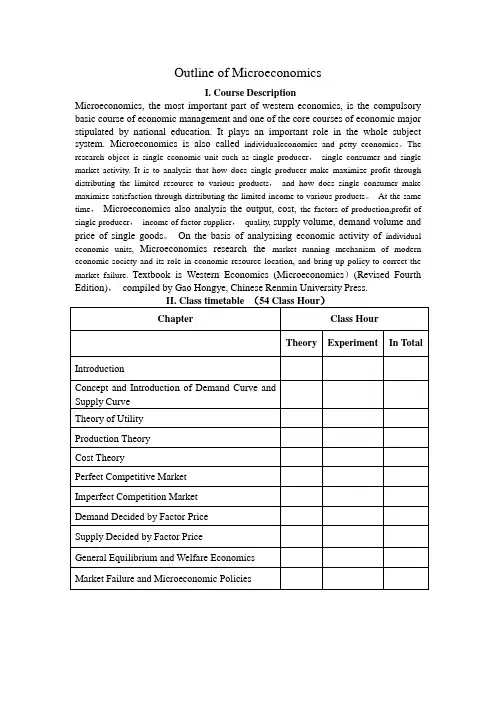
Outline of MicroeconomicsI. Course DescriptionMicroeconomics, the most important part of western economics, is the compulsory basic course of economic management and one of the core courses of economic major stipulated by national education. It plays an important role in the whole subject system. Microeconomics is also called individualeconomics and petty economics。
The research object is single economic unit such as single producer,single consumer and single market activity. It is to analysis that how does single producer make maximize profit through distributing the limited resource to various products,and how does single consumer make maximize satisfaction through distributing the limited income to various products。
At the same time,Microeconomics also analysis the output, cost, the factors of production,profit of single producer,income of factor supplier,quality, supply volume, demand volume and price of single goods。
Macroeconomics 宏观经济学The study of the overall aspects and workings of a national economy, such as income, output, and the interrelationship among diverse economic sectors.研究国民收入的各方面。
Microeconomics 微观经济学The study of the operations of the components of a national economy, such as individual firms, households, and consumers.研究经济中单个因素行为的分析。
GDP 国内生产总值(Gross Domestic Product)The total market value of all final goods and services produced within the borders of a nation during a specified period.一国国民在各行业中一年内生产的最终产品和最终服务价值总和。
It is often seen as an indicator of the standard of living in a country.Gross Domestic Product=consumption + investment goods + government purchases + net exportsEconomic Growth 经济增长steady growth in the productive capacity of the economy (and so a growth of national income)Real Economic Growth Rate 实际经济增长率A measure of economic growth from one period to another expressed as a percentage and adjusted for inflation (i.e. expressed in real as opposed to nominal terms). The real economic growth rate is a measure of the rate of change that a nation's gross domestic product (GDP) experiences from one year to another. Gross national product (GNP) can also be used if a nation's economy is heavily dependent on foreign earnings. The real economic growth rate builds onto the economic growth rate by taking into account the effect that inflation has on the economy. The real economic growth rate is a "constant dollar" and therefore a more accurate look at the rate of economic growth because the real rate is not distorted by the effects of extreme inflation or deflation.GDP deflator GDP指数In economics the GDP deflator (implicit price deflator for GDP) is a measure of the change in prices of all new, domestically produced, final goods and services in an economy. GDP stands for gross domestic product the total value of all goods and services produced within that economy during a specified period.Nominal GDP 名义GDPA gross domestic product (GDP) figure that has not been adjusted for inflation.Real GDP 实际GDPThis inflation-adjusted measure that reflects the value of all goods and services produced in a given year, expressed in base-year prices. Often referred to as "constant-price", "inflation-corrected" GDP or "constant dollar GDP". Unlike nominal GDP, real GDP can account for changes in the price level, and provide a more accurate figure.Potential output 潜在产量/潜在GDPIn economics, potential output (also refered to as "natural real gross domestic product") refers to the highest level of real Gross Domestic Product output that can be sustained over the long term.GDP Gap GDP缺口The forfeited output of an country's economy resulting from the failure to create sufficient jobs for all those willing to work. A GDP gap denotes the amount of production that is irretrievably lost. The potential for higher production levels is wasted because there aren't enough jobs supplied.(与书异)Net Exports 净出口The value of a country's total exports minus the value of its total imports. It is used to calculate a country's aggregate expenditures, or GDP, in an open economy. In other words, net exports is the amount by which foreign spending on a home country's goods and services exceeds the home country's spending on foreign goods and services.Recession 经济衰退A significant decline in activity spread across the economy, lasting longer than a few months. It is visible in industrial production, employment, real income, and wholesale-retail trade. The technical indicator of a recession is two consecutive quarters of negative economic growth as measured by a country's GDP.Notes:Recession is a normal (albeit unpleasant) part of the business cycle. A recession generally lasts from six to eighteen months. Interest rates usually fall in recessionary times to stimulate the economy by offering cheap rates at which to borrowDepression 经济萧条A severe and prolonged recession characterized by inefficient economic productivity, high unemployment, and falling price levels. In times of depression, consumer's confidence and investments decrease, causing the economy to shutdown.Value Added 附加值The enhancement a company gives its product or service before offering the product to customers. This can either increase the products price or value.(与书异)Gross National Product – GNP 国民生产总值An economic statistic that includes GDP, plus any income earned by residents from overseas investments, minus income earned within the domestic economy by overseas residents. GNP is a measure of a country's economic performance, or what its citizens produced (i.e. goods and services) and whether they produced these items within its borders.Disposable Income 可支配收入The amount of after-tax income that is available to divide between spending and personal savings. This also known as your take home pay.Unemployment Rate 失业率The percentage of the total labor force that is unemployed but actively seeking employment and willing to work.Labor force 劳动力the group of people who have a potential for being employed.Frictional Unemployment 摩擦性事业Unemployment that is always present in the economy, resulting from temporary transitions made by workers and employers or from workers and employers having inconsistent or incomplete information.Structural Unemployment 结构性失业Unemployment resulting from changes in the basic composition of the economy. These changes simultaneously open new positions for trained workers.Cyclical Unemployment 周期性失业Unemployment resulting from changes in the business cycle.Natural Unemployment 自然失业率(与书异)The lowest rate of unemployment that an economy can sustain over the long run. Keynesians believe that a government can lower the rate of unemployment (i.e. employ more people) if it were willing to accept a higher level of inflation (the idea behind the Phillips Curve). However, critics of this say that the effect is temporary and that unemployment would bounce back up but inflation would stay high. Thus, the natural, or equilibrium, rate is the lowest level of unemployment at which inflation remains stable. Also known as the "non-accelerating inflation rate of unemployment" (NAIRU).Notes:When the economy is said to be at full employment, it is at its natural rate of unemployment. Economists debate how the natural rate might change. For example, some economists think that increasing labor-market flexibility will reduce the natural rate. Other economists dispute the existence of a natural rate altogether!Frictional unemployment — This reflects the fact that it takes time for people to find and settle into new jobs. If 12 individuals each take one month before they start a new job, the aggregate unemployment statistics will record this as a single unemployed worker. Technological change often reduces frictional unemployment, for example: the internet made job searches cheaper and more comprehensive.Structural unemployment —This reflects a mismatch between the skills and other attributes of the labour force and those demanded by employers. If 4 workers each take six months off to re-train before they start a new job, the aggregate unemployment statistics will record this as two unemployed workers. Technological change often increases structural unemployment, for example: technological change might require workers to re-train.Natural rate of unemployment —This is the summation of frictional and structural unemployment. It is the lowest rate of unemployment that a stable economy can expect to achieve, seeing as some frictional and structural unemployment is inevitable. Economists do not agree on the natural rate, with estimates ranging from 1% to 5%, or on its meaning — some associate it with "non-accelerating inflation.The estimated rate varies from country to country and from time to time.Demand deficient unemployment — In Keynesian economics, any level of unemployment beyond the natural rate is most likelydue to insufficient demand in the overall economy. During a recession, aggregate expenditure is deficient causing the underutilization of inputs (including labour). Aggregate expenditure (AE) can be increased, according to Keynes, by increasing consumption spending (C), increasing investment spending (I), increasing government spending (G), or increasing the net of exports minus imports (X−M).{AE = C + I + G + (X−M)}Okun's Law 奥昆法则A relationship between an economy's GDP gap and the actual unemployment rate. The relationship is represented by a ratio of 1 to 2.5. Thus, for every 1% excess of the natural unemployment rate, a 2.5% GDP gap is predicted.Inflation 通货膨胀The rate at which the general level of prices for goods and services is rising, and, subsequently, purchasing power is falling. Deflation 通货紧缩steadily falling pricesA general decline in prices, often caused by a reduction in the supply of money or credit. Deflation can be caused also by a decrease in government, personal or investment spending. The opposite of inflation, deflation has the side effect of increased unemployment since there is a lower level of demand in the economy, which can lead to an economic depression. Hyperinflation 超级通货膨胀Extremely rapid or out of control inflation.Inflation rate 通货膨胀率In economics, the inflation rate is the rate of increase of the average price level (a measure of inflation). If one likes analogies, the size of a balloon is like the price level, while the inflation rate is how quickly it grows in size. Alternatively, the inflation rate is the rate of decrease in the purchasing power of money.Consumer Price Index (CPI) 消费价格指数The CPI, as it is called, measures the prices of consumer goods and services and is a measure of the pace of US inflation. The US Department of Labor publishes the CPI every month.Demand-pull inflation 需求拉动型通货膨胀inflation due to high demand for GDP and low unemployment, also known as Phillips Curve inflation.Cost-push inflation 成本推动型通货膨胀nowadays termed "supply shock inflation", due to an event such as a sudden increase in the price of oil.Built-in inflation - induced by adaptive expectations, often linked to the "price/wage spiral" because it involves workers trying to keep their wages up with prices and then employers passing higher costs on to consumers as higher prices as part of a "vicious circle". Built-in inflation reflects events in the past, and so might be seen as hangover inflation. It is also known as "inertial" inflation, "inflationary momentum", and even "structural inflation".Indexing 指数化The adjustment of the weights of assets in an investment portfolio so that its performance matches that of an index.Linking movements of rates to the performance of an index.Notes:1. Indexing is a passive investment strategy. An investor can achieve the same risk and return of an index also by investing in an index fund.2. Types of rates that could be linked to the performance of an index are wage or tax rates.Phillips Curve 菲利普斯曲线An economic concept developed by A. W. Phillips stating that inflation and unemployment have a stable and inverse relationship. The theory states that with economic growth comes inflation, which in turn should lead to more jobs and less unemployment. The concept has been proven empirically and some government policies are directly influenced by it.第二章Aggregate Demand 总需求The total amount of goods and services demanded in the economy at a given overall price level and in a given time period. It is represented by the aggregate-demand curve, which describes the relationship between price levels and the quantity of output that firms are willing to provide. Normally there is a negative relationship between aggregate demand and the price level. Alsoknown as "total spending".Notes:Aggregate demand is the demand for the gross domestic product (GDP) of a country, and is represented by this formula: Aggregate Demand (AD) = C + I + G (X-M)C = Consumers' expenditures on goods and services.I = Investment spending by companies on capital goods.G = Government expenditures on publicly provided goods and services.X = Exports of goods and services.M = Imports of goods and services.Aggregate Supply 总供给The total supply of goods and services produced within an economy at a given overall price level in a given time period. It is represented by the aggregate-supply curve, which describes the relationship between price levels and the quantity of output that firms are willing to provide. Normally, there is a positive relationship between aggregate supply and the price level. Rising prices are usually signals for businesses to expand production to meet a higher level of aggregate demand. Also known as "total output".Notes:A shift in aggregate supply can be attributed to a number of variables. These include changes in the size and quality of labor, technological innovations, increase in wages, increase in production costs, changes in producer taxes and subsidies, and changes in inflation. In the short run, aggregate supply responds to higher demand (and prices) by bringing more inputs into the production process and increasing utilization of current inputs. In the long run, however, aggregate supply is not affected by the price level and is driven only by improvements in productivity and efficiency.Exogenous Variable 外生变量A variable whose value is determined outside the model in which it is used.An economic variable that is related to other economic variables and determines their equilibrium levels. For example, rainfall is exogenous to the causal system constituting the process of farming and crop output. An exogenous variable by definition is one whose value is wholly causally independent from other variables in the system.Endogenous Variable 内生变量A value determined within the context of a model.An economic variable which is independent of the relationships determining the equilibrium levels, but nonetheless affects the equilibrium.Consumption 消费in economics, direct utilization of goods and services by consumers, not including the use of means of production, such as machinery and factories (see capital). Consumption can be divided into public and private sectors.Investment 投资An asset or item that is purchased with the hope that it will generate income or appreciate in the future. In an economic sense, an investment is the purchase of goods that are not consumed today but are used in the future to create wealth. In finance, an investment is a monetary asset purchased with the idea that the asset will provide income in the future or appreciate and be sold at a higher price. In the financial sense investments include the purchase of bonds, stocks or real estate property. Government Purchases 政府购买Expenditures made in the private sector by all levels of government, such as when a government entity contracts a construction company to build office space or pave highways. A component of Keynesian expenditures, government purchases can be used as a tool for a government to influence the business cycle and provide economic stimulation when it is deemed necessary. Keynesian Economics 凯恩斯经济An economic theory stating that active government intervention in the marketplace and monetary policy is the best method of ensuring economic growth and stability. A supporter of Keynesian economics believes it is the government's job to smooth out the bumps in business cycles. Intervention would come in the form of government spending and tax breaks in order to stimulate the economy, and government spending cuts and tax hikes in good times, in order to curb inflation.Classical Economics 古典经济学Classical Economics refers to work done by a group of economists in the 18th and 19th centuries. They developed theories about the way markets and market economies work. The study was primarily concerned with the dynamics of economic growth. It stressed economic freedom and promoted ideas such as laissez-faire and free competition. Famous economists of this thinking include Adam Smith, David Ricardo, Thomas Malthus, and John Stuart Mill.Equilibrium of AD and AS 总供给和总需求的均衡supply and demand result in an equilibrium price (the interest rate)Stagflation 滞胀A condition of slow economic growth and relatively high unemployment - a time of stagnation - accompanied by a rise in prices, or inflation.第三章Fiscal Policy 财政政策Government spending policies that influence macroeconomic conditions. These policies affect tax rates, interest rates, and government spending, in an effort to control the economy.Government spending 政府支出consists of government purchases, including transfer payments, which can be financed by seigniorage (the creation of money for government funding), taxes, or government borrowing It is considered to be one of the major components of gross domestic product.Multiplier Effect 乘数效应The expansion of a country's money supply that results from banks being able to lend. The size of the multiplier effect depends on the percentage of deposits that banks are required to hold on reserves. In other words, it is money used to create more money and calculated by dividing total bank deposits by the reserve requirement.The multiplier effect depends on the set reserve requirement. The higher the reserve requirement, the tighter the money supply, which results in a lower multiplier effect for every dollar deposited. The lower the reserve requirement, the larger the money supply, which means more money is being created for every dollar deposited.Crowding Out Effect 挤出效应An economic theory explaining an increase in interest rates due to rising government borrowing in the money market.Notes:Governments often borrow money (by issuing bonds) to fund additional spending. The problem occurs when government debt 'crowds out' private companies and individuals from the lending market. Increased government borrowing tends to increase market interest rates. The problem is that the government can always pay the market interest rate, but there comes a point when corporations and individuals can no longer afford to borrow.Marginal propensity to consume (MPC)边际消费倾向refers to the increase in personal consumer spending (consumption) that occurs with an increase in disposable income (income after taxes and transfers). For example, if a household earns one extra dollar of disposable income, and the marginal propensity to consume is 0.65, then of that dollar, the family will spend 65 cents and save 35 cents.Mathematically, the marginal propensity to consume (MPC) function is expressed as the derivative of the consumption (C) function with respect to disposable income (Y).In other words, the marginal propensity to consume is measured as the ratio of the change in consumption to the change in income, thus giving us a figure between 0 and 1. One minus the MPC equals the marginal propensity to save.Marginal propensity to save (MPS) 边际储蓄倾向refers to the increase in saving (non-purchase of current goods and services) that results from an increase in income. For example, if a family earns one extra dollar, and the marginal propensity to save is 0.35, then of that dollar, the family will spend 65 cents and save 35 cents. It can also go the other way, referring to the decrease in saving that results from a decrease in income. It is crucial to Keynesian economics and is the key variable determining the value of the multiplier. Mathematically, the marginal propensity to save (MPS) function is expressed as the derivative of the savings (S) function with respect to disposable income (Y).In other words, the marginal propensity to save is measured as the ratio of the change in saving to the change in income, thus giving us a figure between 0 and 1. It is the opposite of the marginal propensity to consume (MPC). In the example above, the marginal propensity to consume would be 0.65. In general MPS = 1 - MPC.Money Supply 货币供给(与书异)The entire quantity of bills, coins, loans, credit, and other liquid instruments in a country's economy. Money supply is divided into three categories--M1, M2, and M3--according to the type and size of account in which the instrument is kept. The money supply is important to economists trying to understand how policies will affect interest rates and growth.M1The category of the money supply that includes all physical money like coins and currency. It also includes demand deposits, which are checking accounts and NOW accounts. M1 is the narrowest idea of "money." This is used as a measurement for economists trying to quantify the amount of money in circulation.M2A category within the money supply that includes M1 in addition to all time-related deposits, savings deposits, andnon-institutional money-market funds. M2 is a broader classification of money than M1. Economists use M2 when looking to quantify the amount of money in circulation and trying to explain different economic monetary conditions.M3The category of the money supply that includes M2 as well as all large time deposits, institutional money-market funds, short-term repurchase agreements, along with other larger liquid assets. This is the broadest measure of money it is used by economists to estimate the entire supply of money within an economy.(书没有)Fiat Money 【美】(根据政府法令发行的)不兑现纸币Money that a government has declared to be legal tender, despite the fact that it has no intrinsic value and is not backed by reserves. Most of the world's paper money is fiat money.Legal tender 合法货币;偿付债务时债主必须接受的货币is payment that cannot be refused in settlement of a debt by virtue of law.Transactions demand交易性需求is the demand or foreign currency. It is used for purposes of business transactions and personal consumption. transactions demand is one of the determinants of demand for money (and credit).Speculative demand 投机性需求is the demand for financial assets, such as securities, money or foreign currency, or financing. It is one of the determinants of demand for money (and credit).Liquidity Preference Theory 流动性偏好理论The hypothesis that forward rates offer a premium over expected future spot rates. Proponents of this theory believe that, according to the term structure of interest rates, investors are risk-averse and will demand a premium for securities with longer maturities. A premium is offered by way of greater forward rates in order to attract investors to longer-term securities. The premium received normally increases at a decreasing rate due to downward pressure from the decreasing volatility of interest rates as the term to maturity increases. Also known as "liquidity preference hypothesis."Interest Rate 利率The monthly effective rate paid (or received if you are a creditor) on borrowed money. Expressed as a percentage of the sum borrowed.Nominal Interest Rate/the money interest rate名义利率The interest rate unadjusted for inflation. Not taking into account inflation gives a less realistic number.Real Interest Rate 实际利率The amount by which the nominal interest rate is higher than the inflation rate. The real rate of interest is approximated by taking the nominal interest rate and subtracting inflation. The real interest rate is the growth rate of purchasing power derived from an investment.Intermediate targets 中间目标An intermediate target is a variable (such as the money supply) that is not directly under the control of the central bank, but that does respond fairly quickly to policy actions, is observable frequently and bears a predictable relationship to the ultimate goals of policy.Open Market Operations 公开市场业务The buying and selling of government securities in the open market in order to expand or contract the amount of money in the banking system. Purchases inject money into the banking system and stimulate growth while sales of securities do the opposite. Notes: Open market operations are the principal tools of monetary policy. (The discount rate and reserve requirements are also used.) The U.S. Federal Reserve's goal in using this technique is to adjust the federal funds rate--the rate at which banks borrow reserves from each other.Discount Rate 贴现率The interest rate that an eligible depository institution is charged to borrow short-term funds directly from a Federal Reserve Bank. This type of borrowing from the Fed is fairly limited. Institutions will often seek other means of meeting short-term liquidity needs. The Federal funds discount rate is one of two interest rates the Fed sets, the other being the overnight lending rate, or the Fed funds rate.Lender of Last Resort 最后的贷款者/偿付者An institution, usually a country's central bank, that offers loans to banks or other eligible institutions that are experiencing financial difficulty or are considered highly risky or near collapse. In the U.S. the Federal Reserve acts as the lender of last resort to institutions that do not have any other means of borrowing and whose failure to obtain credit would dramatically affect the economy.Notes: The lender of last resort functions both to protect individuals who have deposited funds, and to prevent panic withdrawing from banks who have temporary limited liquidity. Commercial banks usually try not to borrow from the lender of last resort because such action indicates that the bank is experiencing financial crisis. Critics of the lender-of-last-resort methodology suspect that the safety it provides inadvertently tempts qualifying institutions to acquire more risk than necessary - since they are more likely to perceive the potential consequences of risky actions to be less severe.Reserve Requirements 法定准备金Requirements regarding the amount of funds that banks must hold in reserve against deposits made by their customers. This money must be in the bank's vaults or at the closest Federal Reserve Bank.Notes: Set by the Fed's Board of Governors, reserve requirements are one of the three main tools of monetary policy. The other two tools are open market operations and the discount rate. Also known as required reserves.第四章Supply-side economics 供给经济学A theory of economics that reductions in tax rates will stimulate investment and in turn will benefit the entire society.Laffer Curve 拉弗尔曲线Invented by Arthur Laffer, this curve shows the relationship between tax rates and tax revenue collected by governments. The chart below shows the Laffer Curve:The curve suggests that, as taxes increase from low levels, tax revenue collected by the government also increases. It also shows that tax rates increasing after a certain point (T*) would cause people not to work as hard or not at all, thereby reducing tax revenue. Eventually, if tax rates reached 100% (the far right of the curve), then all people would choose not to work because everything they earned would go to the government.Notes: Governments would like to be at point T*, because it is the point at which the government collects maximum amount of tax revenue while people continue to work hard.Tax revenue税收is the income that is gained by governments because of taxation of the peopleBudget deficit 联邦预算赤字The amount by which government spending exceeds government revenues.Unemployment benefits 失业救济are sums of money given to the unemployed by the government or a compulsory para-governmental insurance system. Depending on the jurisdiction and the status of the person, those sums may be meager, covering only basic needs (thus a form of basic welfare), or may compensate the lost pay somewhat proportionally to the previous earned salary. They often are part of a larger social security scheme. Unemployment benefits are generally given only to those registering as unemployed, and often on conditions ensuring that they seek work and do not currently have a job.Capital Stock 资本存量The common and preferred stock a company is authorized to issue, according to their corporate charter.Notes: Capital stock are normally listed on a company's balance sheet. In financial statement analysis, an increasing capital stock account tends to be a sign of economic health since the company can use the additional proceeds to invest in projects or machinery that will increase corporate profits and/or efficiency.i ncomes policies 收入政策are wage and price controls used to fight inflation.第五章Mercantilism 重商主义is the economic theory that a nation's prosperity depends upon its supply of capital and that the total volume of trade is unchangeable. The amount of capital, represented by bullion(金条), is best increased through a favourable balance of trade. Mercantilism suggests that the government should advance these goals by playing an active, protectionist role in the economy by encouraging exports and discouraging imports, especially through the use of tariffs. The economic policy that flourished in the early modern period is often referred to as the mercantile system.Trade deficit or surplus 贸易逆差或顺差The difference in the value of a nation's imports over exports (deficit) or exports over imports (surplus).Trade Surplus 贸易顺差/ export surplus出口顺差A nation's excess of exports over imports during a given time frame.Zero-Sum Game。
微观经济学原理曼昆名词解释稀缺性(scarcity):社会资源的有限性。
经济学(economics):研究社会如何管理自己的稀缺资源。
效率(efficiency):社会能从其稀缺资源中得到最多东西的特性。
平等(equality):经济成果在社会成员中公平分配的特性。
机会成本(opportunity cost):为了得到某种东西所必须放弃的东西。
理性人(rational people):系统而有目的地尽最大努力实现起目标的人。
边际变动(marginal change):对行动计划微小的增量调整。
激励(incentive):引起一个人做出某种行为的某种东西。
市场经济(market economy):当许多企业和家庭在物品与劳务市场上相互交易时,通过他们的分散决策配置资源的经济。
产权(property rights):个人拥有并控制稀缺资源的能力。
市场失灵(market failure):市场本身不能有效配置资源的情况。
外部性(externality):一个人的行为对旁观者福利的影响。
市场势力(market power):一个经济活动者(或经济活动者的一个小集团)对市场价格有显著影响的能力。
生产率(productivity):一个工人一小时所生产的物品与劳务量。
通货膨胀(inflation):经济中物价总水平的上升。
经济周期(business cycle):就业和生产等经济活动的波动(就是生产这类经济活动的波动。
)循环流向图(circular-flow diagram):一个说明货币如何通过市场在家庭与企业之间流动的直观经济模型。
生产可能性边界(production possibilities frontier):表示一个经济在可得到的生产要素与生产技术既定时所能生产的产量的各种组合的图形。
微观经济学(microeconomics):研究家庭和企业如何做出决策,以及它们在市场上的相互交易。
宏观经济学(macroeconomics):研究整体经济现象,包括通货膨胀、失业和经济增长。
微观经济学常用词汇Aaccounting 会计accounting cost 会计成本accounting profit 会计利润adverse selection 逆向选择allocation 配置allocation of resources 资源配置allocative efficiency 配置效率antitrust legislation 反托拉斯法Assumption 假设asymetric information 非对称性信息average cost 平均成本average fixed cost 平均固定成本average product of capital 资本平均产量average product of labor 劳动平均产量average revenue 平均收益average total cost 平均总成本average variable cost 平均可变成本Bbarriers to entry 进入壁垒base year 基年bilateral monopoly 双边垄断benefit 收益boundary point 边界点break even point 收支相抵点budget 预算budget constraint 预算约束budget line 预算线budget set 预算集Ccapital 资本capital stock 资本存量capital output ratio 资本产出比率capitalism 资本主义cardinal utility theory 基数效用论cartel 卡特尔ceteris puribus assumption “其他条件不变”的假设ceteris puribus demand curve 其他因素不变的需求曲线change in demand 需求变化change in quantity demanded 需求量变化change in quantity supplied 供给量变化change in supply 供给变化choice 选择closed set 闭集Coase theorem 科斯定理Cobb—Douglas production function 柯布--道格拉斯生产函数collective bargaining 集体协议工资collusion 合谋command economy 指令经济commodity 商品commodity combination 商品组合commodity market 商品市场commodity space 商品空间common property 公用财产comparative static analysis 比较静态分析compensated budget line 补偿预算线compensated demand function 补偿需求函数compensation principles 补偿原则compensating variation in income 收入补偿变量competition 竞争competitive market 竞争性市场complement goods 互补品complete information 完全信息completeness 完备性condition for efficiency in exchange 交换的最优条件condition for efficiency in production 生产的最优条件concave function 凹函数consistence 一致性constant cost industry 成本不变产业constant returns to scale 规模报酬不变constraints 约束consumer 消费者consumer behavior 消费者行为consumer choice 消费者选择consumer equilibrium 消费者均衡consumer optimization 消费者优化consumer preference 消费者偏好consumer surplus 消费者剩余consumer theory 消费者理论consumption 消费consumption bundle 消费束consumption combination 消费组合consumption possibility curve 消费可能曲线consumption possibility frontier 消费可能性前沿consumption set 消费集continuity 连续性continuous function 连续函数convex function 凸函数convex preference 凸偏好convex set 凸集corporatlon 公司cost 成本cost benefit analysis 成本收益分析cost function 成本函数cost minimization 成本极小化Cross—price elasticity 交叉价格弹性Ddecreasing cost industry 成本递减产业decreasing returns to scale 规模报酬递减deduction 演绎法demand 需求demand curve 需求曲线demand elasticity 需求弹性demand function 需求函数demand price 需求价格demand schedule 需求表depreciation 折旧derivative 导数derive demand 派生需求difference equation 差分方程differential equation 微分方程diminishing marginal substitution 边际替代率递减diminishing marginal return 收益递减diminishing marginal utility 边际效用递减direct taxes 直接税discounting 贴税、折扣diseconomies of scale 规模不经济disequilibrium 非均衡distribution 分配division of labor 劳动分工distribution theory of marginal productivity 边际生产率分配论duality 对偶durable goods 耐用品dynamic analysis 动态分析dynamic models 动态模型EEconomic agents 经济行为者economic cost 经济成本economic efficiency 经济效率economic goods 经济物品economic man 经济人economic mode 经济模型economic profit 经济利润economic region of production 生产的经济区域economic regulation 经济调节economic rent 经济租金exchange 交换economics 经济学exchange efficiency 交换效率economy 经济exchange contract curve 交换契约曲线economy of scale 规模经济exclusion 排斥性、排他性efficiency 效率,效益efficiency parameter 效率参数elasticity 弹性elasticity of substitution 替代弹性endogenous variable 内生变量endowment 禀赋endowment of resources 资源禀赋Engel curve 恩格尔曲线entrepreneur 企业家entrepreneurship 企业家才能entry barriers 进入壁垒entry/exit decision 进出决策equilibrium 均衡equilibrium condition 均衡条件equilibrium price 均衡价格equilibrium quantity 均衡产量equity 公平equivalent variation in income 收入等价变量excess—capacity theorem 过度生产能力定理excess supply 过度供给exchange 交换exclusion 排斥性、排他性exclusion principle 排他性原则exogenous variables 外生变量expectation 期望expected utility 期望效用expected value 期望值expenditure 支出explicit cost 显性成本external benefit 外部收益external cost 外部成本external economy 外部经济external diseconomy 外部不经济externalities 外部性FFactor 要素factor demand 要素需求factor market 要素市场factors of production 生产要素factor substitution 要素替代factor supply 要素供给final goods 最终产品firm 企业firms’ demand curve for labor 企业劳动需求曲线firm supply curve 企业供给曲线first—order condition 一阶条件fixed costs 固定成本fixed input 固定投入fixed proportions production function 固定比例的生产函数flow 流量fluctuation 波动for whom to produce 为谁生产free entry 自由进入free mobility of resources 资源自由流动free rider 搭便车,免费搭车function 函数future value 未来值Ggame theory 对策论、博弈论general equilibrium 总体均衡Gini coefficient 基尼系数goods 货物government failure 政府失败government regulation 政府调控Hhomogeneous product 同质产品household 家庭how to produce 如何生产human capital 人力资本hypothesis 假说Iidentity 恒等式imperfect competition 不完全竞争implicit cost 隐性成本income 收入income constraint 收入约束income consumption curve 收入消费曲线income distribution 收入分配income effect 收入效应income elasticity of demand 需求收入弹性increasing cost industry 成本递增产业increasing returns to scale 规模报酬递增inefficiency 缺乏效率index number 指数indifference 无差异indifference curve 无差异曲线individual demand curve 个人需求曲线individual demand function 个人需求函数induced variable 引致变量induction 归纳法industry 产业industry equilibrium 产业均衡industry supply curve 产业供给曲线inelastic 缺乏弹性的inferior goods 劣品information 信息information cost 信息成本initial condition 初始条件initial endowment 初始禀赋innovation 创新input 投入input—output 投入—产出institution 制度institutional economics 制度经济学insurance 保险interest 利息interest rate 利息率intermediate goods 中间产品internatization of externalities 外部性内部化investment 投资invisible hand 看不见的手isocost line 等成本线isoprofit curve 等利润曲线isoquant curve 等产量曲线Kkinded—demand curve 弯折的需求曲线Llabor 劳动labor demand 劳动需求labor supply 劳动供给labor theory of value 劳动价值论labor unions 工会laissez faire 自由放任Lagrangian function 拉格朗日函数Lagrangian multiplier 拉格朗乘数land 土地law 法则law of demand and supply 供求法则law of diminishing marginal utility 边际效用递减法则law of diminishing marginal rate of substitution 边际替代率递减法则law of diminishing marginal rate of technical substitution 边际技术替代率law of increasing cost 成本递增法则least—cost combination of inputs 最低成本的投入组合leisure 闲暇licenses 许可证linear demand function 线性需求函数long run长期long run average cost 长期平均成本long run equilibrium 长期均衡long run marginal cost 长期边际成本long run total cost 长期总成本Lorenz curve 洛伦兹曲线loss minimization 损失极小化luxury 奢侈品Mmacroeconomics 宏观经济学marginal 边际的marginal benefit 边际收益marginal cost 边际成本marginal cost pricing 边际成本定价marginal cost of factor 边际要素成本marginal period 市场期marginal physical productivity 实际实物生产率marginal product 边际产量marginal product of capital 资本的边际产量marginal product of 1abour 劳动的边际产量marginal productivity 边际生产率marginal rate of substitution 边际替代率marginal rate of transformation 边际转换率marginal returns 边际回报marginal revenue 边际收益marginal revenue product 边际收益产品marginal revolution 边际革命marginal social benefit 社会边际收益marginal social cost 社会边际成本marginal utility 边际效用marginal value products 边际价值产品market 市场market clearance 市场出清market demand 市场需求market economy 市场经济market equilibrium 市场均衡market failure 市场失败market mechanism 市场机制market structure 市场结构market separation 市场分割market regulation 市场调节market share 市场份额Marshallian demand function 马歇尔需求函数maximization 极大化microeconomics 微观经济学minimum wage 最低工资misallocation of resources 资源误置mixed economy 混合经济model 模型money 货币monopolistic competition 垄断竞争monopolistic exploitation 垄断剥削monopoly 垄断,卖方垄断monopoly equilibrium 垄断均衡monopoly pricing 垄断定价monopoly regulation 垄断调控monopoly rents 垄断租金monopsony 买方垄断NNash equilibrium 纳什均衡Natural monopoly 自然垄断Natural resources 自然资源Necessary condition 必要条件necessities 必需品net demand 净需求non--zero—sum game 非零和对策normal goods 正常品normal profit 正常利润normative economics 规范经济学Oobjective function 目标函数oligopoly 寡头垄断oligopoly market 寡头市场oligopoly model 寡头模型opportunity cost 机会成本optimal choice 最优选择optimal consumption bundle 最优消费束perfect elasticity 完全有弹性optimal resource allocation 最佳资源配置optimal scale 最佳规模optimal solution 最优解optimization 优化ordering of optimization(social) preference (社会)偏好排序ordinary goods 一般品output 产量、产出output elasticity 产出弹性Pparameter 参数Pareto criterion 帕累托标准Pareto efficiency 帕累托效率Pareto improvement 帕累托改进Pareto optimality 帕累托优化partial derivative 偏导数partial equilibrium 局部均衡patent 专利perfect competition 完全竞争perfect complement 完全互补品perfect monopoly 完全垄断perfect price discrimination 完全价格歧视perfect substitution 完全替代品perfect inelasticity 完全无弹性perfectly elastic 完全有弹性perfectly inelastic 完全无弹性plant size 工厂规模point elasticity 点弹性positive economics 实证经济学post Hoc Fallacy 后此谬误prediction 预测preference 偏好preference relation 偏好关系present value 现值price 价格price adjustment model 价格调整模型price ceiling 最高限价price consumption curve 价格消费曲线price control 价格管制price difference 价格差别price discrimination 价格歧视price elasticity of demand 需求价格弹性price elasticity of supply 供给价格弹性price floor 最低限价price maker 价格制定者price rigidity 价格刚性price seeker 价格搜求者price taker 价格接受者price tax 从价税private benefit 私人收益principal—agent issues 委托--代理问题private cost 私人成本private goods 私人用品private property 私人财产producer equilibrium 生产者均衡producer theory 生产者理论product 产品product transformation curve 产品转换曲线product differentiation 产品差异production 生产production efficiency 生产效率production function 生产函数production possibility curve 生产可能性曲线productivity 生产率productivity of capital 资本生产率productivity of labor 劳动生产率profit 利润profit function 利润函数profit maximization 利润极大化property rights 产权property rights economics 产权经济学proposition 定理proportional demand curve 成比例的需求曲线public benefits 公共收益public choice 公共选择public goods 公共商品pure competition 纯粹竞争rivalry 对抗性、竞争pure exchange 纯交换pure monopoly 纯粹垄断Qquantity tax 从量税quasi—rent 准租金Rrate of product transformation 产品转换率rationality 理性regulation 调节,调控relative price 相对价格rent 租金rent control 规模控制rent seeking 寻租rent seeking economics 寻租经济学resource 资源resource allocation 资源配置returns 报酬、回报returns to scale 规模报酬revealed preference 显示性偏好revenue 收益revenue curve 收益曲线revenue function 收益函数revenue maximization 收益极大化risk 风险Ssatiation 饱和,满足saving 储蓄scarcity 稀缺性law of scarcity 稀缺法则second derivative 一阶导数second—order condition 二阶条件service 劳务set 集shadow prices 影子价格short—run 短期short—run cost curve 短期成本曲线short—run equilibrium 短期均衡short—run supply curve 短期供给曲线shortage 短缺single price monopoly 单一定价垄断slope 斜率social benefit 社会收益social cost 社会成本social security 社会保障social welfare function 社会福利函数socialism 社会主义solution 解space 空间stability 稳定性stable equilibrium 稳定的均衡static analysis 静态分析stock 存量stock market 股票市场strategy 策略subsidy 津贴substitutes 替代品substitution effect 替代效应substitution parameter 替代参数sufficient condition 充分条件supply 供给supply curve 供给曲线supply function 供给函数supply schedule 供给表symmetry 对称性symmetry of information 信息对称Ttangency 相切taste 兴致technical efficiency 技术效率technological constraints 技术约束technological progress 技术进步technology 技术total cost 总成本total effect 总效应total expenditure 总支出total fixed cost 总固定成本total product 总产量total revenue 总收益total utility 总效用total variable cost 总可变成本traditional economy 传统经济transitivity 传递性transaction cost 交易成本Uuncertainty 不确定性unit elasticity 单位弹性unstable equilibrium 不稳定均衡utility 效用utility function 效用函数utility index 效用指数utility maximization 效用极大化utility possibility curve 效用可能性曲线VValue 价值value judge 价值判断value of marginal product 边际产量价值variable cost 可变成本variable input 可变投入variables 变量vector 向量visible hand 看得见的手vulgur economics 庸俗经济学Wwage 工资wage rate 工资率Walras general equilibrium 瓦尔拉斯总体均衡Welfare criterion 福利标准Welfare economics 福利经济学welfare maximization 福利最优化Zzero cost 零成本zero elasticity 零弹性zero economic profit 零利润。
1.绝对优势(Absolute advantage)如果一个国家用一单位资源生产的某种产品比另一个国家多,那么,这个国家在这种产品的生产上与另一国相比就具有绝对优势。2.逆向选择(Adverse choice)在此状况下,保险公司发现它们的客户中有太大的一部分来自高风险群体。3.选择成本(Alternative cost)如果以最好的另一种方式使用的某种资源,它所能生产的价值就是选择成本,也可以称之为机会成本。4.需求的弧弹性( Arc elasticity of demand)如果P1和Q1分别是价格和需求量的初始值,P2 和Q2 为第二组值,那么,弧弹性就等于-(Q1-Q2)(P1+P2)/(P1-P2)(Q1+Q2)5.非对称的信息(Asymmetric information)在某些市场中,每个参与者拥有的信息并不相同。例如,在旧车市场上,有关旧车质量的信息,卖者通常要比潜在的买者知道得多。6.平均成本(Average cost)平均成本是总成本除以产量。也称为平均总成本。7.平均固定成本( Average fixed cost)平均固定成本是总固定成本除以产量。8.平均产品(Average product)平均产品是总产量除以投入品的数量。9.平均可变成本(Average variable cost)平均可变成本是总可变成本除以产量。10.投资的β(Beta)β度量的是与投资相联的不可分散的风险。对于一种股票而言,它表示所有现行股票的收益发生变化时,一种股票的收益会如何敏感地变化。11.债券收益(Bond yield)债券收益是债券所获得的利率。12.收支平衡图(Break-even chart)收支平衡图表示一种产品所出售的总数量改变时总收益和总成本是如何变化的。收支平衡点是为避免损失而必须卖出的最小数量。13.预算线(Budget line)预算线表示消费者所能购买的商品X和商品Y的数量的全部组合。它的斜率等于商品X的价格除以商品Y的价格再乘以一1。14.捆绑销售(Bundling)捆绑销售指这样一种市场营销手段,出售两种产品的厂商,要求购买其中一种产品的客户,也要购买另一种产品。15.资本(Capital)资本是指用于生产、销售及商品和服务分配的设备、厂房、存货、原材料和其他非人力生产资源。16.资本收益(Capital gain)资本收益是指人们卖出股票(或其他资产)时所获得的超过原来为它支付的那一部分。17.资本主义(Capitalism)资本主义是一种市场体系,它依赖价格体系去解决基本的经济问题:生产什么?如何生产?怎样分配?经济增长率应为多少?18.基数效用(Cardinal utility)基数效用是指像个人的体重或身高那样在基数的意义上可以度量的效用(它意味着效用之间的差别,即边际效用,是有意义的)。序数效用与它相反,它只在序数的层面上才有意义。19.卡特尔(Cartel)卡特尔是指厂商之间为了合谋而签订公开和正式协议这样一种市场结构形态。20. 科布一道格拉斯生产函数是指这样的生产函数Q=AL“IK”2 Mi3。式中,Q为产量;L为劳动的数量;K为资本的数量;M为原材料的数量;A,31,12,23均为常数。21.勾结(Collision) 勾结是指一个厂商和同业内其他的厂商签订有关价格、产量和其他事宜的协议。22.比较优势(Comparative advantage)如果与生产其他商品的成本相比,一个国家生产的某种产品的成本比另一个国家低,那么,该国就在这种商品的生产上与另一个国家相比具有比较优势。23.互补品(Complements)如果X和Y是互补品,X的需求量就与Y的价格成反向变化。24.成本不变行业(Constant-cost industry)成本不变的行业是指具有水平的长期供给曲线的行业,它的扩大并不会引起投入品价格的上升或下降。25.规模收益不变(Constant returns to scale)如果所有投入品的数量都以相同的百分数增加,并导致产量也以相同的百分数增加,就是规模收益不变的。26.消费者剩余(Consumer surplus)消费者剩余是指消费者愿意为某种商品或服务所支付的最大数量与他实际支付的数量之差。27.可竞争市场(Contestable market)可竞争市场是指那种进入完全自由以及退出没有成本的市场。可竞争市场的本质在于它们很容易受到打了就跑的进入者的伤害。28.契约曲线(Contract curve)契约曲线是(在消费者之间进行交换时)两个消费者的边际替代率相等的点的轨迹,或者(在生产者之间进行交换时)两个生产者的边际技术替代率相等的点的轨迹。29.角点解(Corner solution)角点解是指这样一种情形,预算线在位于坐标轴上的点处达到最高的可获得的30.需求的交叉弹性(Cross elasticity of demand)需求的交叉弹性是指商品Y的价格发生1%的变化时所引起的商品X的需求量变化的百分比。31.垄断的无谓损失(Deadweight loss of monopoly)如果一个完全竞争的市场转变为一个垄断的市场,这种转变所带来的总剩余的减少就是无谓损失。32.买方垄断的无谓损失(Deadweight loss of monopsony)如果一个完全竞争的市场转变成一个买方垄断的市场,这种转变所带来的总剩余的减少即为无谓损失.33.成本递减行业(Decreasing-cost industry)成本递减行业是指具有向下倾斜的长期供给曲线的行业,它的扩大会引起平均成本下降。34.规模收益递减( Decreasing return to scale)如果所有投入品的数量都以相同的百分数增加,并导致产量增加的百分数小于该百分数 ,就是规模收益递减的。35.需求曲线(Demand curve)需求曲线表示在每一价格下所需求的商品数量。36.可贷资金的需求曲线(Demand curve of loanable funds)可贷资金的需求曲线表示可贷资金的需求量与利率二者之间的关系。37.贴现率( Discount rate)当利率用于计算投资的净现值时,它被称为贴现率。38.可分散风险(Diversifiable risk)可以通过多样化来避免的风险是可分散风险。39.主导厂商( Dominant firm)在寡头垄断的行业中,主导厂商是一个制定价格的大型厂商,它允许该行业中的小厂商在此价格下销售它们想出售的全部数量的商品。40.优势策略(Dominant strategy)不论其他局中人采取什么策略,优势策略对一个局中人而言都是最好的策略。41.双头垄断(Duopoly)双头垄断是指有两个卖主这样一种市场结构。古诺模型,以及其他模型中都涉及双头垄断。42.经济效率(Economic efficiency)经济效率是指这样一种状况,所进行的任何改变都不会给任何人带来损失而能增加一些人的福利。这样一种状态就是经济的有效率状况(或者帕累托效率或帕累托最优)。43.经济利润(Economic profit)经济利润是指厂商的收益与它的成本之差,后者包括从最有利的另外一种厂商资源的使用中可以获得的收益。44.生产的经济区域(Economic region of production)生产的经济区域是指等产量线斜率为负的投入品组合。没有一个厂商会在等产量线斜率为正的点上运行,因为在这种点上总会有一种投入品的边际产品为负。45.经济资源(Economic resource)经济资源是指一种稀缺的、要求一个非零价格的资源。46.范围经济(Economies of scope)范围经济是指由厂商的范围而非规模带来的经济。只要把两种或更多的产品合并在一起生产比分开来生产的成本要低,就会存在范围经济。47.有效市场假说(Efficient markets hypothesis)根据这一假设,投资者在买卖股票时会迅速有效地利用可能的信息.所有已知的影响一种股票价格的因素都已经反映在股票的价格中,因此根据这一理论,股票的技术分析是无效的。(这个假设有三种形式。)48.财富状况(Endowment position)财富状况是指消费者每年的收人。49.恩格尔曲线(Engel curve)恩格尔曲线反映的是所购买的一种商品的均衡数量与消费者收入水平之间的关系。它是以19世纪德国的统计学家恩斯特•恩格尔的名字命名的。50.均衡(Equilibrium)均衡是指没有任何变化趋势的状态。例如,均衡价格就是一种能够维持的价格。51.过剩生产能力(Excess capacity)过剩生产能力是指成本最低产量与长期均衡中的实际产量之差。52垄.断竞争理论有一个著名的且颇有争论的结论,它认为这种市场结构之下的厂商往往会在还有过剩生产能力的情况下进行生产。53.扩张路径( Expansion path)扩张路径是指与各种产量相对应的等产量线与等成本线相切的点的轨迹。(所有投入品都是可变的。)54.期望货币价值(Expected monetary vale)为了确定一项投机的期望货币价值,计算每一种可能出现的结果的货币收益(或损失) 与其出现的概率相乘以后的和。55.预期利润(Expected profit)预期利润就是长期的平均利润值,也就是用所出现的概率加权以后的各种可能的利润水平之和。56.完全信息的预期价值(Expected value of perfect information) 完全信息的预期价值是指决策者获得完全信息所导致的预期的货币价值的增加。它是决策者为获得完全的信息而能支付的最大数量。57.显成本(Explicit costs)显成本是指账目上所包括的厂商的正常费用,诸如工资成本和原材料支付。58.外部不经济(External diseconomy)外部不经济是指由于消费或者其他人和厂商的产出所引起的一个人或厂商无法补偿的成本。59.外部经济(External economy)外部经济是指由于消费或者其他人和厂商的产出所引起的一个人或厂商无法索取的收益。60.先动优势(First-mover advantages)先动优势是由于在博弈中第一个采取行动的局中人所拥有的优势。61.固定成本(Fixed cost)固定成本为每个时期不变投入品的总成本。62.不变投人品(FIXed input)不变投入品是指生产过程中所使用的(如厂房和设备)、在考察的期间数量不变的资源。63.自由资源(Free resource)自由资源是指特别富裕以致在零价格就可以获得的资源64.一般均衡分析(General equilibrium analysis)一般均衡分析是指(与局部均衡分析相反)把各种市场和价格的相互作用都考虑进去的分析。65.吉芬反论(Giffen`s paradox)吉芬反论是指商品的需求量与价格成正向关系这样一种状况。当劣质商品价格的替代效应并不足以抵消收人效应时就会发生这样的情况。66.隐成本(Implicit cost)使用企业所有者拥有的资源(诸如他的时间与资本)的选择成本就是隐成本。 67.收入补偿的需求曲线( Income-compensated demand curve)收入补偿的需求曲线表示,当消费者的收入调整到不论价格如何都可以购买最初的市场篮子,这时在每一种价格下消费者所需求的商品的数量有多少。68.收入--消费曲线(Income-consumption curve)收入一消费曲线是把代表与全部可能的消费者货币收入相应的均衡市场篮子的点连接而成的一条曲线。这种曲线可以用于推导恩格尔曲线。69.收人效应(Income effect)收入效应是指,所有价格不变时完全由于消费者满足水平的变化所引起的商品X的需求量的改变。70.需求的收入弹性(income elasticity of demand)需求的收入弹性是指,当价格保持不变时消费者收入发生1%的变化时,所引起的需求数量变化的百分比。71.成本递增的产业(Increasing-cost industry)成本递增的行业是指具有向上倾斜的长期供给曲线的行业,它的扩大会引起投入品价格的上升。72.规模收益递增(increasing returns to scale)如果所有投入品的数量都以相同的百分数增加,并导致产量增加的百分数大于该百分数 ,就是规模收益递增的。73.无差异曲线(Indifference curve)无差异曲线表示对消费者没有区别的市场篮子的点的轨迹。74.劣质商品(Inferior good)劣质商品是指其收入效应使得实际收人增加导致需求量减少的商品。75.创新(Innovation)当一项发明第一次使用时,我们称之为创新。76.投人品(Input)生产过程中所使用的任何资源都是投入品。77.利率(lnterest rate)如果他借出1美元一年,一年后借出者收到的贴水为利率。如果利率为r,他一年后将收到(1+r)美元。78.中间品(Intermediate good)中间品是指用于生产其他商品和服务的产品。79.内部收益率(Internal rate of return)内部收益率是使一项投资项目的净现金流的现值等于项目投资支出的利率。80.投资(Investment)投资是指创造新资产的过程。81.投资需求曲线( Investment demand curve)投资需求曲线表示投资的总数量与额外1美元投资的收益率之间的关系。82.等成本曲线( Isocost curve)等成本曲线表示一个固定的总支出所能得到的各种投入品组合。83.等利润曲线( Isoprofit curve)等利润曲线表示能够产生某一利润水平的所有投入品组合。84.等产量曲线(Isoquant)等产量曲线表示能够产生某一产量的所有可能的(有效率的)投入品组合.85.等收益线( lsorevenue line)等收益线表示能够产生相同总收益的两种商品产量的全部组合。86.折弯的需求曲线(Kinked demand curve)折弯的需求曲线是垄断厂商面对的在现行的价格下有一个折点的需求曲线,需求在价格上升时要比价格下降时更富有弹性。87.劳动( Labor)劳动是指生产商品和服务的过程中所使用的人们的努力、体力和脑力。88.土地( Land)土地是指用于生产的、包括矿产和土地在内的自然资源。89.边际收益递减律(Law of diminishing marginal returns)根据这一法则,如果不断添加相同增量的一种投入品(且若其他投入品保持不变),这样所导致的产品增量在超过某一点后将会下降,也就是说,边际产品将会减少。90.边际效用递减律(Law of diminishing marginal utility)根据这一法则,当一个人消费越来越多的某种商品时(其他商品的消费保持不变),商品的边际效用最终会趋于下降.91.勒纳指数(Lerner index)勒纳指数度量一个厂商所拥有的垄断势力的大小,它等于(P—MC)/P,此处P是厂商的价格,MC是边际成本。92.学习曲线(Learning curve)学习曲线表示一种商品的平均成本与生产者的累积总产量之间的关系。 93.限制性定价(Limit pricing)限制性定价是指为了阻止其他厂商进人而采取的一种定价。限制性价格是一种使得进入者失望或阻止它们进入的价格。94.长期(Long run)长期是指所有投入品都是可变的时间期限。在长期中厂商可以全部改变它所使用的资源。95.边际成本(Marginal cost)边际成本是指由于增加最后一单位产量导致的总成本的增加。96.边际成本定价(Marginal cost pricing)边际成本定价是指这样一种定价规则,厂商或国有企业使得价格等于边际成本。97.边际支出曲线(Manginal expenditure curve)边际支出曲线表示厂商增加1单位投人品X所引起的成本的增加。98.边际产品(Marginal product)边际产品是指由于增加最后一单位某种投入品(其他投入品的数量保持不变)所带来的总产量的增加。99.边际产品转换率(Marginal rate of product transformation)边际产品转换率是指生产可能性曲线斜率的负数。100.边际替代率(Marginal rate of substitution)边际替代率是指如果消费者在收到额外一单位商品X之后要保持满足水平不变而必须放弃的商品Y的数量。101.边际收益(Marginal revenue)边际收益是指出售额外一单位产品所带来的总收益的增加。102.边际收益产品(Marginal revenue product)边际收益产品是指由于使用额外一单位投入品X所带来的总收益的增加。边际收益产品是指由于使用额外一单位投入品X所带来的总收益的增加。它等于投入X的边际产品乘以厂商的边际收益。103.边际效用( Marginal utility)边际效用是指(当所有其他的商品的消费水平保持不变时)从额外一单位商品中所获得额外满足(即效用)。104.市场(Market)市场是指为了买和卖某些商品而与其他厂商和个人相联系的一群厂商和个人。105.市场需求曲线(Market demand curve)市场需求曲线表示在整个市场中产品的价格和它的需求量之间的关系。106.市场周期(Market period)市场周期是指一种商品的供给量保持不变的一段时期。107.市场结构( Market structure)四种一般的市场类型是完全竞争、垄断、垄断竞争和寡头垄断。一个市场的结构依赖于买者和卖者的数量以及产品差别的大小。108.市场供给表( Market supply schedule)市场供给表表示在各种价格下一种商品所能够供给的数量。109.加成定价(Markup pricing)加成定价是指,为了确定一种产品的价格而把一个百分比(或绝对的)数量加到所估计的产品平均(或边际的)成本上,这就意味着该数量要计入某些无法化归任何具体产品中去的成本,并且旨在维持厂商的某一投资回报率。110.最大最小策略(Maximin strategy)最大最小策略是指局中人使得能够获得的最小收益最大化的策略。111.微观经济学(Microeconomics)微观经济学是经济学的一部分,它分析像消费者、厂商和资源所有者这些个体的经济行为(宏观经济学与之相反,它分析像国内总产品这样的经济总体行为)。112.工厂的最小有效规模(Minimum efficient size of plant)在长期中平均成本处于或接近其最小值的最小的工厂规模。模型(Model)模型是指以对现实进行简化和抽象的假设为基础的理论,根据它可以引申出对现实世界的预测或结论。113.货币收人(Money income)货币收入是指用每个时期的实际美元数量度量的消费者的收入。114.垄断竞争(Monopolistic competition)垄断竞争是指这样一种市场结构,在该市场中有很多有差别产品的卖者,进入很容易并且厂商之间没有勾结行为。115.垄断(Monopoly)垄断是指一种产品只有一个卖者的市场结构。公共事业通常就是这样的情形。116.买方垄断(Monopsony)买方垄断是指一种产品只有一个买者的市场结构。雇用一个工业城镇的全部劳动力的厂商就是一个例子。117.道德风险(Moral hazard)道德风险是指,在购买了保险之后一个人或厂商的行为发生变化以致增加了保险公司承担的盗窃、火灾和其他损失发生的概率。 118.跨国公司(Multinational firm)跨国公司是指在其他国家投资并且在国外生产和销售产品的厂商。119.多厂垄断( Multiplant monopoly)多厂垄断是指拥有和经营不止一个工厂并且要决定每个工厂产量的一个厂商。 120.多产品厂商( Multiproduct firm)多产品厂商是指生产不止一种产品的厂商。例如,杜邦公司生产化工、石油等方面的种类繁多的产品。 121.共同基金(Mutual fund)共同基金是把大量投资者和雇员的钱集中在一起,从而购买各个厂商的股票。 122.纳什均衡(Nash equilibrium)纳什均衡是指博弈论中的一种均衡,如果给出每个其他局中人的策略,在此均衡下,所有局中人都没有理由改变他自己的策略。 123.自然垄断(Natural monopoly)自然垄断是指这样一种行业,在此行业中,在产量大到足以满足全部市场的情况下商品的平均成本达到最小,因此不可能存在竞争,仅有的一个厂商就成为垄断者.124.净现值规则(Net-Present-Value Rule)净现值规则要求厂商应该从事净现值为正的投资项目。投资的净现值是投资未来现金流的现值减去投资的成本。 125.不可分散的风险(Nondiversifiable risk)不可分散的风险是指不能通过多样化来减小的风险。126.非价格竞争(Nonprice competition)由研究开发和风格的变化使商品特征的各种改变,以及厂商间的广告与其他营销手段来进行的竞争,都是非价格竞争。 127.正常商品(Normal goods)需求量随消费者的实际收入上升而增加的商品称为正常商品。 128.寡头垄断(Oligopoly)寡头垄断是指这样一种市场形态,在其中只有少数卖者,商品可以是同质的也可以是有差别的。例如,计算机和石油市场就是这样的。 129.买方寡头垄断(Oligopsony)买方寡头垄断是指只有少数买者的市场形态。 130.机会成本(Opportunity cost)如果以最好的另一种方式利用某种资源,它所能生产出来的价值为机会成本,也称为选择成本。131.最优投人品组合(Optimal input combination)如果投入品组合是经济上有效率的或者使得利润最大化(也就是说,从利润最大化的厂商的角度出发是最优的)或者两者兼而有之,这一组合就是最优投入品组合。132.序数效用(Ordinal utility)在序数的意义上可以度量的效用是序数效用,这表明一个消费者只能根据各种市场篮子给他带来的满足来给这些市场篮子排序。133.帕累托标准(Pareto criterion)帕累托标准是确定一种改变是否是一种改进的标准,根据这一标准,不损害任何人而能使大多数人(在他们看来)变得更好的改变才是一种改进。134.局部均衡分析( Partial equilibrium analysis)局部均衡分析是指这样一种分析,(与一般均衡分析相反)它假设一个市场上的价格改变时不会导致其他市场的价格发生明显的变化。135.货币收益( Pecuniary benefits)由于经济对一个项目的调整引起的相对价格的变化带来的收益(用以与增加社会福利的真实收益相区别)。136.完全竞争(Perfect Competition)完全竞争是这样一种市场结构,在其中同质的商品有很多卖者,没有一个卖者或买者能控制价格,进入很容易并且资源可以随时从一个使用者转向另一个使用者。例如,许多农产品市场就具有完全竞争市场这些特征。137.不可兑换的公司债券(Perpetuity)不可兑换的公司债券是指永远支付一个固定年息的债券。138.掠夺性定价( Predatory pricing)掠夺性定价是指为了把竞争性厂商从行业中赶走从而制定一个低价的做法。139.现值( Present value)现值是现在和将来(或过去)的一笔支付或支付流在今天的价值。140.最高限价(Price ceiling)最高限价是指政府对某种商品所规定的最高价格。例如,纽约市的租金控制就规定了房租的上限。141.价格--消费曲线(Pric-consumption curve)价格--消费线是把与在一种商品的各种价格下消费者所选择的市场篮子相对应的各个均衡点连接而成的一条曲线。142.价格歧视( Price discrimination)价格歧视是指这样一种做法,出售同一种商品,厂商向一个买者索取的价格高于其他的买者。143.富有价格弹性(Price elastic)如果需求的价格弹性大于1,那么商品的需求就是富有价格弹性。144.需求的价格弹性(Price elasticity of demand)需求的价格弹性是指价格变化1%导致的需求量变化的百分比(习惯上通常以正数表示 )。145.供给的价格弹性(Price elasticity of supply)供给的价格弹性是指价格变化1%导致的供给量变化的百分比。146.最低限价(Price floor)最低限价是指政府对某种商品所规定的最低价格。例如,联邦农业计划规定了小麦和玉米的最低价格。147.缺乏价格弹性(Price inelastic)如果需求的价格弹性小于1,那么商品的需求就是缺乏价格弹性。148.价格领导者( Price leader)价格领导者是指在寡头垄断的行业中制定价格并且其他厂商愿意跟随的厂商。149.价格系统(Price system)在价格系统下,商品和服务都有一个价格,在纯粹的资本主义经济中价格执行一个经济系统的基本职能(决定生产什么、怎样生产、每个人应该得到多少以及一个国家的增长率应该是多少)。150.委托--代理问题(Principal-agent problem)由于经理或工人可能会追求自己的目标,即便这样做会减少企业所有者的利润,从而导致了委托--代理问题。经理或工人是为所有者工作的代理人,所有者是委托人。151.囚犯困境(Prisoner`s dilemma)囚犯困境是指这样一种情形,此时两个人(或厂商)合作要比不合作好,但是每个人都觉得不合作符合他的利益,因此每个人的状况都要坏于如果他们合作时的境况。152.私人成本(Private cost)私人成本是指单个使用者为了能够使用某一资源而带来的费用。153.概率(Probability)概率是指在长期中某种结果发生的次数与总次数之比。例如,如果多次掷骰子并且 1 点出现的次数是总次数的 1/6,那么出现 1点的概率就是 1/6。154.生产者剩余(Producer surplus)生产者剩余等于厂商生产一种产品的总利润加上补偿给要素所有者超出和低于他们所要求的最小收益的数量。从几何的角度看,它等于价格曲线之下、供给曲线之上的区域。155.生产可能性曲线( Production possibilities curve)生产可能性曲线表示用一定数量的资源所能够生产出来的两种商品的各种数量组合。156.生产函数(Production function)生产函数表示在每个时期所使用的各种投入品的数量与每个时期所能生产出来的最大产量之间的关系 157.利润(Profit)厂商的收益减去它的成本就是利润。 158.公共物品(Public good)公共物品是指非竞争性和非排他性的物品。所谓非竞争性,意指为另一个消费者提供这一物品所带来的边际成本为零。所谓非排他性,意指不能排除其他人消费这一物品(不论他们是否付费)。 159.准租金(Quasi-rent)准租金是指对供给暂时不变的投入品的支付。例如,厂商的厂房在短期中是不能改变的,对它和其他不变投人品的支付就是准租金。 160.配额(Quota)配额是指对一种商品每年能够进口的数量所施加的限制。161.射线(Ray)射线是指从某些点出发向空间延伸的线。如果资本在一个轴上,劳动在另外一个轴上,那么从原点出发的一条射线就描述了资本一劳动比率不变的全部投入品组合。 162.反应曲线( Reaction curve) 反应曲线表示一个双头垄断者生产和销售多少数量,该曲线依赖于一个厂商认为另一个双头垄断。
经济学单词Aaccounting 会计accounting cost 会计成本accounting profit 会计利润adverse selection 逆向选择allocation 配置allocation of resources 资源配置allocative efficiency 配置效率antitrust legislation 反托拉斯法arc elasticity 弧弹性Arrow's impossibility theorem 阿罗不可能定理Assumption 假设asymetric information 非对称性信息average 平均average cost 平均成本average cost pricing 平均成本定价法average fixed cost 平均固定成本average product of capital 资本平均产量average product of labour 劳动平均产量average revenue 平均收益average total cost 平均总成本average variable cost 平均可变成本Bbarriers to entry 进入壁垒base year 基年bilateral monopoly 双边垄断benefit 收益black market 黑市bliss point 极乐点boundary point 边界点break even point 收支相抵点budget 预算budget constraint 预算约束budget line 预算线budget set 预算集Ccapital 资本capital stock 资本存量capital output ratio 资本产出比率capitalism 资本主义cardinal utility theory 基数效用论cartel 卡特尔ceteris puribus assumption “其他条件不变”的假设ceteris puribus demand curve 其他因素不变的需求曲线Chamberlin model 张伯伦模型change in demand 需求变化change in quantity demanded 需求量变化change in quantity supplied 供给量变化change in supply 供给变化choice 选择closed set 闭集Coase theorem 科斯定理Cobb—Douglas production function 柯布--道格拉斯生产函数cobweb model 蛛网模型collective bargaining 集体协议工资collusion 合谋command economy 指令经济commodity 商品commodity combination 商品组合commodity market 商品市场commodity space 商品空间common property 公用财产comparative static analysis 比较静态分析compensated budget line 补偿预算线compensated demand function 补偿需求函数compensation principles 补偿原则compensating variation in income 收入补偿变量competition 竞争competitive market 竞争性市场complement goods 互补品complete information 完全信息completeness 完备性condition for efficiency in exchange 交换的最优条件condition for efficiency in production 生产的最优条件concave 凹concave function 凹函数concave preference 凹偏好consistence 一致性constant cost industry 成本不变产业constant returns to scale 规模报酬不变constraints 约束consumer 消费者consumer behavior 消费者行为consumer choice 消费者选择consumer equilibrium 消费者均衡consumer optimization 消费者优化consumer preference 消费者偏好consumer surplus 消费者剩余consumer theory 消费者理论consumption 消费consumption bundle 消费束consumption combination 消费组合consumption possibility curve 消费可能曲线consumption possibility frontier 消费可能性前沿consumption set 消费集consumption space 消费空间continuity 连续性continuous function 连续函数contract curve 契约曲线convex 凸convex function 凸函数convex preference 凸偏好convex set 凸集corporatlon 公司cost 成本cost benefit analysis 成本收益分cost function 成本函数cost minimization 成本极小化Cournot equilihrium 古诺均衡Cournot model 古诺模型Cross—price elasticity 交叉价格弹性Ddead—weights loss 重负损失decreasing cost industry 成本递减产业decreasing returns to scale 规模报酬递减deduction 演绎法demand 需求demand curve 需求曲线demand elasticity 需求弹性demand function 需求函数demand price 需求价格demand schedule 需求表depreciation 折旧derivative 导数derive demand 派生需求difference equation 差分方程differential equation 微分方程differentiated good 差异商品differentiated oligoply 差异寡头diminishing marginal substitution 边际替代率递减diminishing marginal return 收益递减diminishing marginal utility 边际效用递减direct approach 直接法direct taxes 直接税discounting 贴税、折扣diseconomies of scale 规模不经济disequilibrium 非均衡distribution 分配division of labour 劳动分工distribution theory of marginal productivity 边际生产率分配论duoupoly 双头垄断、双寡duality 对偶durable goods 耐用品dynamic analysis 动态分析dynamic models 动态模型EEconomic agents 经济行为者economic cost 经济成本economic efficiency 经济效率economic goods 经济物品economic man 经济人economic mode 经济模型economic profit 经济利润economic region of production 生产的经济区域economic regulation 经济调节economic rent 经济租金exchange 交换economics 经济学exchange efficiency 交换效率economy 经济exchange contract curve 交换契约曲线economy of scale 规模经济Edgeworth box diagram 埃奇沃思图exclusion 排斥性、排他性Edgeworth contract curve 埃奇沃思契约线Edgeworth model 埃奇沃思模型efficiency 效率,效益efficiency parameter 效率参数elasticity 弹性elasticity of substitution 替代弹性endogenous variable 内生变量endowment 禀赋endowment of resources 资源禀赋Engel curve 恩格尔曲线entrepreneur 企业家entrepreneurship 企业家才能entry barriers 进入壁垒entry/exit decision 进出决策envolope curve 包络线equilibrium 均衡equilibrium condition 均衡条件equilibrium price 均衡价格equilibrium quantity 均衡产量eqity 公平equivalent variation in income 收入等价变量excess—capacity theorem 过度生产能力定理excess supply 过度供给exchange 交换exchange contract curve 交换契约曲线exclusion 排斥性、排他性exclusion principle 排他性原则existence 存在性existence of general equilibrium 总体均衡的存在性exogenous variables 外生变量expansion paths 扩展径expectation 期望expected utility 期望效用expected value 期望值expenditure 支出explicit cost 显性成本external benefit 外部收益external cost 外部成本external economy 外部经济external diseconomy 外部不经济externalities 外部性FFactor 要素factor demand 要素需求factor market 要素市场factors of production 生产要素factor substitution 要素替代factor supply 要素供给fallacy of composition 合成谬误final goods 最终产品firm 企业firms’demand curve for labor 企业劳动需求曲线firm supply curve 企业供给曲线first-degree price discrimination 第一级价格歧视first—order condition 一阶条件fixed costs 固定成本fixed input 固定投入fixed proportions production function 固定比例的生产函数flow 流量fluctuation 波动for whom to produce 为谁生产free entry 自由进入free goods 自由品,免费品free mobility of resources 资源自由流动free rider 搭便车,免费搭车function 函数future value 未来值Ggame theory 对策论、博弈论general equilibrium 总体均衡general goods 一般商品Giffen goods 吉芬晶收入补偿需求曲线Giffen's Paradox 吉芬之谜Gini coefficient 吉尼系数goldenrule 黄金规则goods 货物government failure 政府失败government regulation 政府调控grand utility possibility curve 总效用可能曲线grand utility possibility frontier 总效用可能前沿Hheterogeneous product 异质产品Hicks—kaldor welfare criterion 希克斯一卡尔多福利标准homogeneity 齐次性homogeneous demand function 齐次需求函数homogeneous product 同质产品homogeneous production function 齐次生产函数horizontal summation 水平和household 家庭how to produce 如何生产human capital 人力资本hypothesis 假说Iidentity 恒等式imperfect competion 不完全竞争implicitcost 隐性成本income 收入income compensated demand curve income constraint 收入约束income consumption curve 收入消费曲线income distribution 收入分配income effect 收入效应income elasticity of demand 需求收入弹性increasing cost industry 成本递增产业increasing returns to scale 规模报酬递增inefficiency 缺乏效率index number 指数indifference 无差异indifference curve 无差异曲线indifference map 无差异族indifference relation 无差异关系indifference set 无差异集indirect approach 间接法individual analysis 个量分析individual demand curve 个人需求曲线individual demand function 个人需求函数induced variable 引致变量induction 归纳法industry 产业industry equilibrium 产业均衡industry supply curve 产业供给曲线inelastic 缺乏弹性的inferior goods 劣品inflection point 拐点information 信息information cost 信息成本initial condition 初始条件initial endowment 初始禀赋innovation 创新input 投入input—output 投入—产出institution 制度institutional economics 制度经济学insurance 保险intercept 截距interest 利息interest rate 利息率intermediate goods 中间产品internatization of externalities 外部性内部化invention 发明inverse demand function 逆需求函数investment 投资invisible hand 看不见的手isocost line 等成本线,isoprofit curve 等利润曲线isoquant curve 等产量曲线isoquant map 等产量族Kkinded—demand curve 弯折的需求曲线Llabour 劳动labour demand 劳动需求labour supply 劳动供给labour theory of value 劳动价值论labour unions 工会laissez faire 自由放任Lagrangian function 拉格朗日函数Lagrangian multiplier 拉格朗乘数,land 土地law 法则law of demand and supply 供需法law of diminishing marginal utility 边际效用递减法则law of diminishing marginal rate of substitution 边际替代率递减法则law of diminishing marginal rate of technical substitution 边际技术替代率law of increasing cost 成本递增法则law of one price 单一价格法则leader—follower model 领导者--跟随者模型least—cost combination of inputs 最低成本的投入组合leisure 闲暇Leontief production function 列昂节夫生产函数licenses 许可证linear demand function 线性需求函数linear homogeneity 线性齐次性linear homogeneous production function 线性齐次生产函数long run长期long run average cost 长期平均成本long run equilibrium 长期均衡long run industry supply curve 长期产业供给曲线long run marginal cost 长期边际成本long run total cost 长期总成本Lorenz curve 洛伦兹曲线loss minimization 损失极小化1ump sum tax 一次性征税luxury 奢侈品Mmacroeconomics 宏观经济学marginal 边际的marginal benefit 边际收益marginal cost 边际成本marginal cost pricing 边际成本定价marginal cost of factor 边际要素成本marginal period 市场期marginal physical productivity 实际实物生产率marginal product 边际产量marginal product of capital 资本的边际产量marginal product of 1abour 劳动的边际产量marginal productivity 边际生产率marginal rate of substitution 边替代率marginal rate of transformation 边际转换率marginal returns 边际回报marginal revenue 边际收益marginal revenue product 边际收益产品marginal revolution 边际革命marginal social benefit 社会边际收益marginal social cost 社会边际成本marginal utility 边际效用marginal value products 边际价值产品market 市场market clearance 市场结清,市场洗清market demand 市场需求market economy 市场经济market equilibrium 市场均衡market failure 市场失败market mechanism 市场机制market structure 市场结构market separation 市场分割market regulation 市场调节market share 市场份额markup pricing 加减定价法Marshallian demand function 马歇尔需求函数maximization 极大化microeconomics 微观经济学minimum wage 最低工资misallocation of resources 资源误置mixed economy 混合经济model 模型money 货币monopolistic competition 垄断竞争monopolistic exploitation 垄断剥削monopoly 垄断,卖方垄断monopoly equilibrium 垄断均衡monopoly pricing 垄断定价monopoly regulation 垄断调控monopoly rents 垄断租金monopsony 买方垄断NNash equilibrium 纳什均衡Natural monopoly 自然垄断Natural resources 自然资源Necessary condition 必要条件necessities 必需品net demand 净需求nonconvex preference 非凸性偏好nonconvexity 非凸性nonexclusion 非排斥性nonlinear pricing 非线性定价nonrivalry 非对抗性nonprice competition 非价格竞争nonsatiation 非饱和性non--zero—sum game 非零和对策normal goods 正常品normal profit 正常利润normative economics 规范经济学Oobjective function 目标函数oligopoly 寡头垄断oligopoly market 寡头市场oligopoly model 寡头模型opportunity cost 机会成本optimal choice 最佳选择optimal consumption bundle 消费束perfect elasticity 完全有弹性optimal resource allocation 最佳资源配置optimal scale 最佳规模optimal solution 最优解optimization 优化ordering of optimization(social) preference (社会)偏好排序ordinal utility 序数效用ordinary goods 一般品output 产量、产出output elasticity 产出弹性output maximization 产出极大化Pparameter 参数Pareto criterion 帕累托标准Pareto efficiency 帕累托效率Pareto improvement 帕累托改进Pareto optimality 帕累托优化Pareto set 帕累托集partial derivative 偏导数partial equilibrium 局部均衡patent 专利pay off matrix 收益矩阵、支付矩阵perceived demand curve 感觉到的需求曲线perfect competition 完全竞争perfect complement 完全互补品perfect monopoly 完全垄断perfect price discrimination 完全价格歧视perfect substitution 完全替代品perfect inelasticity 完全无弹性perfectly elastic 完全有弹性perfectly inelastic 完全无弹性plant size 工厂规模point elasticity 点弹性positive economics 实证经济学post Hoc Fallacy 后此谬误prediction 预测preference 偏好preference relation 偏好关系present value 现值price 价格price adjustment model 价格调整模型price ceiling 最高限价price consumption curve 价格费曲线price control 价格管制price difference 价格差别price discrimination 价格歧视price elasticity of demand 需求价格弹性price elasticity of supply 供给价格弹性price floor 最低限价price maker 价格制定者price rigidity 价格刚性price seeker 价格搜求者price taker 价格接受者price tax 从价税private benefit 私人收益principal—agent issues 委托--代理问题private cost 私人成本private goods 私人用品private property 私人财产producer equilibrium 生产者均衡producer theory 生产者理论product 产品product transformation curve 产品转换曲线product differentiation 产品差异product group 产品集团production 生产production contract curve 生产契约曲线production efficiency 生产效率production function 生产函数production possibility curve 生产可能性曲线productivity 生产率productivity of capital 资本生产率productivity of labor 劳动生产率profit 利润profit function 利润函数profit maximization 利润极大化property rights 产权property rights economics 产权经济学proposition 定理proportional demand curve 成比例的需求曲线public benefits 公共收益public choice 公共选择public goods 公共商品pure competition 纯粹竞争rivalry 对抗性、竞争pure exchange 纯交换pure monopoly 纯粹垄断Qquantity—adjustment model 数量调整模型quantity tax 从量税quasi—rent 准租金Rrate of product transformation 产品转换率rationality 理性reaction function 反应函数regulation 调节,调控relative price 相对价格rent 租金rent control 规模报酬rent seeking 寻租rent seeking economics 寻租经济学resource 资源resource allocation 资源配置returns 报酬、回报returns to scale 规模报酬revealed preference 显示性偏好revenue 收益revenue curve 收益曲线revenue function 收益函数revenue maximization 收益极大化ridge line 脊线risk 风险Ssatiation 饱和,满足saving 储蓄scarcity 稀缺性law of scarcity 稀缺法则second—degree price discrimination 二级价格歧视second derivative --阶导数second—order condition 二阶条件service 劳务set 集shadow prices 影子价格short—run 短期short—run cost curve 短期成本曲线short—run equilibrium 短期均衡short—run supply curve 短期供给曲线shut down decision 关闭决策shortage 短缺shut down point 关闭点single price monopoly 单一定价垄断slope 斜率social benefit 社会收益social cost 社会成本social indifference curve 社会无差异曲线social preference 社会偏好social security 社会保障social welfare function 社会福利函数socialism 社会主义solution 解space 空间stability 稳定性stable equilibrium 稳定的均衡Stackelberg model 斯塔克尔贝格模型static analysis 静态分析stock 存量stock market 股票市场strategy 策略subsidy 津贴substitutes 替代品substitution effect 替代效应substitution parameter 替代参数sufficient condition 充分条件supply 供给supply curve 供给曲线supply function 供给函数supply schedule 供给表Sweezy model 斯威齐模型symmetry 对称性symmetry of information 信息对称Ttangency 相切taste 兴致technical efficiency 技术效率technological constraints 技术约束technological progress 技术进步technology 技术third—degree price discrimination 第三级价格歧视total cost 总成本total effect 总效应total expenditure 总支出total fixed cost 总固定成本total product 总产量total revenue 总收益total utility 总效用total variable cost 总可变成本traditional economy 传统经济transitivity 传递性transaction cost 交易费用Uuncertainty 不确定性uniqueness 唯一性unit elasticity 单位弹性unstable equilibrium 不稳定均衡utility 效用utility function 效用函数utility index 效用指数utility maximization 效用极大化utility possibility curve 效用可能性曲线utility possibility frontier 效用可能性前沿Vvalue 价值value judge 价值判断value of marginal product 边际产量价值variable cost 可变成本variable input 可变投入variables 变量vector 向量visible hand 看得见的手vulgur economics 庸俗经济学Wwage 工资wage rate 工资率Walras general equilibrium 瓦尔拉斯总体均衡Walras's law 瓦尔拉斯法则Wants 需要Welfare criterion 福利标准Welfare economics 福利经学Welfare loss triangle 福利损失三角形welfare maximization 福利极大化Zzero cost 零成本zero elasticity 零弹性zero homogeneity 零阶齐次性zero economic profit 零利润中级微观经济学单词Optimal choice 最优选择Indifference curve 无差异曲线Utility function 效用函数Derivative 导数Differential 微分Partial derivative 偏导数Implicit function 隐函数Utility (label) 效用(标记)Marginal Rate of Substitution 边际替代率(MRS)Exponent 指数Cobb-Douglas Preferences 柯布—道格拉斯偏好Monotonic Transformation 单调变换Numerator 分子Denominator 分母MRS is independent of the utility representation 边际替代率与表示的方法无关Coefficient 系数Unknown parameters 未知参数Absolute value 绝对值Slope 斜率Marginal utility itself has no behavioral content 边际效用本身并没有行为方面的内容Algebraic 代数的Natural log 自然对数Quasilinear utility 拟线性效用Quasilinear Preferences 拟线性偏好Constant 常数Perfect Substitutes 完全替代Perfect Complements 完全互补Intuitive 直观的Intersect 相交Construct a utility function 构造效用函数Rule out 排除Compelling 令人信服的An operational criterion 可操作的标准Cardinal utility 基数效用Geometrically 几何学地Composite function 复合函数First derivative 一阶导数second 二阶Infinite 无限多种Ordinal utility 序数效用Consumer preferences 消费者偏好The magnitude of the utility function is only important insofar as it ranks the different consumption bundles. 效用函数的数值,在对不同消费束进行排序时才有意义。